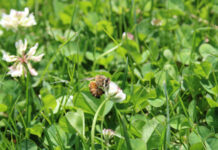By Dr. Jack Fry & Christine Menapace
From the December 2023 Issue
Identifying seeding windows for cool-season grasses can be difficult in many regions because weather is so different from year to year. Yet “dormant” seeding, which generally occurs from now into March, can offer an opportunity to makeup for missed windows during the hustle of Spring and Fall. It also means grass emergence will occur at the earliest possible Spring date, pleasing clients and giving you a jump on the season. Finally, it can also be an opportunity for Winter revenue if plowing is scarce.
In the North, turfgrasses are currently dormant and the seed you scatter in mid-Winter will also remain “dormant.” That is, until warmer conditions and moisture return in the Spring. Tall fescue germination, for instance, is optimized with soil temperatures between 59 ̊ and 72 ̊F. Seed applied in Winter will remain inactive in the soil until it warms to near 60 ̊F, and then it will begin to germinate. Other grasses which are candidates for dormant seeding include other species of cool-season grasses, and even warm-season grasses such as buffalograss and Bermudagrass.

Seed-to-soil contact is critical. If conditions are dry, vertical mowing or slit seeding may be possible. Additionally, a light topdressing of soil applied over seed can also maximize seed-to-soil contact. Seeding on frozen soil is also possible, and seed-to-soil contact is improved as the soil thaws and freezes, which creates cracks in the surface in which seed can lie. Covering or mixing seed with the soil, where it will likely remain for a number of weeks before germination, also prevents it from being a source of food for birds and rodents.
Twenty years ago, Ward Upham, a Kansas State University Extension Associate in Horticulture and Natural Resources, conducted a study to evaluate the effects of different dormant seeding months on the success of tall fescue cover in May. He seeded plots on the 15th of each month from December through March onto bare soil that had been tilled and raked. On May 18, plots seeded in February and March each had an average of 80% coverage. December and January seedings were each at about 60% coverage. Ward suspected that having dormant seed out in the environment longer made it subject to erosion and consumption.
Disadvantages

Ideally, Fall is the preferred time for seeding, so keep in mind that with dormant seeding, stand establishment may not be as successful. And, just like Spring seeding, weed competition will be greater as the stand matures. In addition, weather doesn’t always cooperate, and mid-Winter may be too wet. However, if just small areas need seeding on a client property, you can even sprinkle some seed by hand.
It’s also important to note that preemergent herbicides applied in late Fall or Spring may inhibit germination and growth of the seedlings. Preemergent herbicides that can be used in many seedbeds include siduron (Tupersan) and mesotrione (Tenacity). Always check labels prior to use.
Dormant Fertilization
Just as lawns benefit from dormant seeding, they can also benefit from dormant feeding or late Fall/early Winter fertilization. It’s important to note, however, the timeline for this application is earlier than dormant seeding, since fertilizing on frozen ground can lead to runoff and pollute local waterways.
Jaime Staufenbeil, a Milorganite agronomist, says dormant fertilization is for cool-season, Northern grass varieties such as Kentucky bluegrass, fescue, and perennial ryegrass. Dormant feeding isn’t necessary for warm-season grasses.
The application should occur just before the first deep freeze or snowfall — generally after Halloween, but before Thanksgiving — but it depends on the weather in your area, she says. If the ground is already frozen, you’ll need to wait until Spring. To check if a lawn is already frozen, try inserting a screwdriver 6″ in the soil.
Turf Care: Optimal Overseeding
You can’t guarantee clients a perfect lawn after overseeding, but you can stack the deck in your favor by following these tips. Read more…
It’s important to use a slow-release, nitrogen fertilizer which will stay on the soil until moisture and temperature conditions are just right to break down the nutrients in Spring. Quick-release fertilizers should not be used for dormant feeding, since they could signal a lawn to start growing again and a late-season growth spurt accompanied by a hard freeze can be especially damaging. Apply a pound of nitrogen per thousand square feet for dormant fertilization, writes Staufenbeil in the Milorganite blog, but always check instructions on the bag, as well as state and local fertilization laws.
With dormant fertilization and/or dormant seeding, client lawns will green up earlier and healthier and be ready for Spring success.
Fry is a professor and commercial turf extension specialist with the Department of Horticulture and Natural Resources at Kansas State University/Olathe Horticulture Center. He contributed the section on dormant seeding.
For more on Milorganite, see milorganite.com.
Do you have a comment? Share your thoughts in the Comments section below, or send an e-mail to the Editor at cmenapace@groupc.com.











![[VIDEO] Dickies®: Discover Workwear That’s Anything But Uniform](https://turfmagazine.com/wp-content/uploads/2023/06/1647663814-4b1a2a7742790a9b1e97a3b963477850192e1d6a9dfba9b07214a77bae25d6e3-d-218x150.jpg)



























 Turf Care: Optimal Overseeding
Turf Care: Optimal Overseeding


![[VIDEO] Dickies®: Discover Workwear That’s Anything But Uniform](https://turfmagazine.com/wp-content/uploads/2023/06/1647663814-4b1a2a7742790a9b1e97a3b963477850192e1d6a9dfba9b07214a77bae25d6e3-d-324x160.jpg)